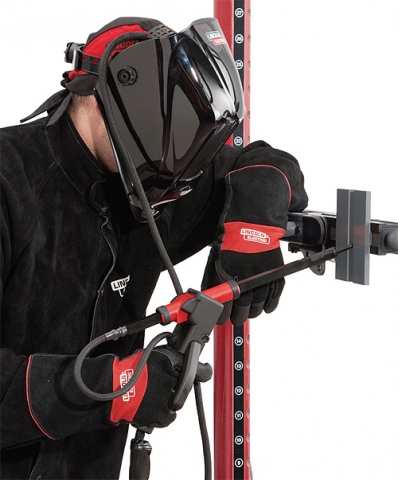Welding Simulator Slashes Training Costs and Materials
Arc welding processes require good workmanship to produce sound welds. Poor technique such as an overly long distance between the electrode and the work piece (arc length) can make the difference between a smooth, strong weld and a defective one that is prone to failure. Learning the skill requires time, patience, and significant amounts of materials.
In an effort to reduce the cost of training and train welders faster, the Lincoln Electric Co. and software development partner VRSim developed the VRTEX 360 welding simulator. The system features a welding helmet retrofit to display a virtual-reality environment, with an ultra-realistic hand piece enabled by stepper motors from MICROMO to bring the shop floor welding experience to the classroom. Users can see immediate results of their efforts from the detailed quantitative feedback.
Traditionally, learning to weld has been a matter of trial and error. It is a skill requiring students to go through a lot of materials until they absorb the technique needed to consistently turn out good product. The VRTEX 360 provides a way for students to log hours of practice without consuming excessive amounts of materials.
When students don the virtual-reality welding helmet, they enter a virtual worksite. The electrode holder behaves similarly to those on real stick welders. When the student strikes an arc with the simulator, they hear the sound of welding and they see the bead forming as they move the virtual reality electrode holder. As they continue to weld, the electrode retracts as though it was melting, forcing them to adjust to maintain proper arc length.
The simulator also presents the virtual weld on an adjacent monitor along with a detailed analysis that both student and instructor can access for quantitative feedback. During the weld, the instructor can monitor real-time metrics such as arc length, electrode angle, and travel speed, then review the data afterward with the student. The system can help new students master the technique more quickly and experienced welders to learn new skills.
The value of the VRTEX 360 lies in the realistic behavior of the electrode which retracts into the hand piece by more than 7-in., simulating the way an electrode melts away during the course of a weld. The Lincoln Electric engineering team needed to design a mechanical assembly to move the electrode in response to feedback. Because burn rate varies depending on materials and process conditions, a fixed-speed dc motor would not be effective. Rather, the system required a motor with variable-speed motion, was simple in design, performed reliably, and delivered the required torque in a small package.
Lead engineer Antonius Aditjandra chose a two-phase PreciStep micro-stepper motor. MICROMO also supplied the wiring harness, simplifying the assembly process and eliminating the chance that a motor might be damaged in the wire-bonding process.
Although stepper motors are often run open loop, the motor in the VRTEX 360 required feedback for accurate simulation. A sensor monitors the distance between the end of the electrode and the coupon, as well as rod angle and speed. This allows it to monitor user performance and properly simulate the process.
Normally, it would seem that a low-torque motor would be sufficient to handle such lightweight material. Not so, says Aditjandra. “Manufacturing plastic is always a challenge because of the 0.020-in. tolerance. Any out-of-tolerance part will create friction. I wanted to make sure that the stepper motor had enough torque to actually push through the worst-case scenario.”
In addition, the housing had to fit the manufacturing tolerances of the molded plastic parts. Performance consistency was more important. The value of a simulator lies in delivering a measured, repeatable experience. “Consistency of torque is important because when students are building their muscle memory, they need to be sure that they’re feeding the consumables at the proper burn rates,” added Aditjandra.




